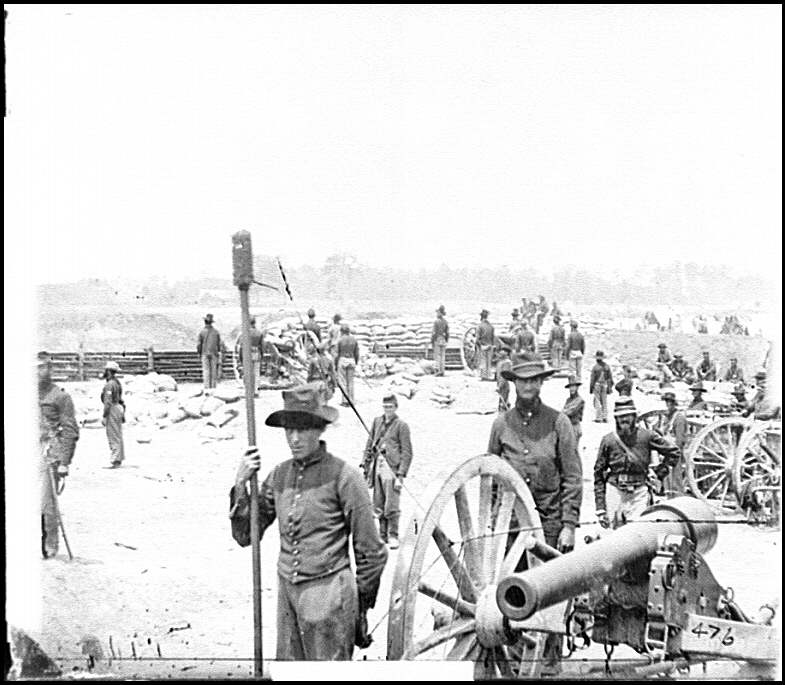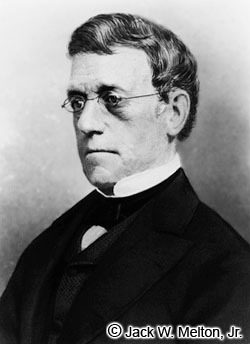To: All
"Cavalry Crossing a Ford":
Walt Whitman’s Alabama Connection
In July of 1864, Walt Whitman was a relatively unknown, under-employed, forty-five year old poet, living in Washington, D.C. With the war on, he supported himself by working part-time copying documents in the army paymaster’s office. He also served as a volunteer nurse to war casualties. His real work, however, was completing his volume of war poetry, Drum-taps, which drew heavily on his experiences caring for the injured and dying. Included in the collection, published in 1865, was "Cavalry Crossing a Ford," a seven-line poem that is widely considered one of Whitman’s best. In the Fall issue of Alabama Heritage, Betty Barrett reveals intriguing evidence that the cavalry in question were Union troops under the command of Gen. Lovell H. Rousseau, and the ford they crossed was at Ten Islands on the Coosa River in St. Clair County, Alabama. In fact, not only does the poem recreate a scene from Rousseau’s July 1864 raid through Alabama, it relies heavily on the language and imagery of an anonymous war correspondent’s report of the events.
Betty Barrett
A line in long array where they wind betwixt green islands,
They take a serpentine course, their arms flash in the sun--
hark to the musical clank,
Behold the silvery river,
in it the splashing horses loitering stop to drink,
Behold the brown-faced men, each group, each person a picture,
the negligent rest on the saddles,
Some emerge on the opposite bank, others are just entering the ford--while,
Scarlet and blue and snowy white,
The guidon flags flutter gayly in the wind. Walt Whitman |
3 posted on
04/22/2004 12:01:33 AM PDT by
SAMWolf
(Stress is when you wake up screaming & you realize you haven't fallen asleep yet.)
To: All

Veterans for Constitution Restoration is a non-profit, non-partisan educational and grassroots activist organization. The primary area of concern to all VetsCoR members is that our national and local educational systems fall short in teaching students and all American citizens the history and underlying principles on which our Constitutional republic-based system of self-government was founded. VetsCoR members are also very concerned that the Federal government long ago over-stepped its limited authority as clearly specified in the United States Constitution, as well as the Founding Fathers' supporting letters, essays, and other public documents.

Tribute to a Generation - The memorial will be dedicated on Saturday, May 29, 2004.

Actively seeking volunteers to provide this valuable service to Veterans and their families.

Iraq Homecoming Tips
~ Thanks to our Veterans still serving, at home and abroad. ~ Freepmail to Ragtime Cowgirl | 2/09/04 | FRiend in the USAF
PDN members and fans. We hope you will consider this simple act of patriotism worth passing on or taking up as a project in your own back yard. In summary:
Who They Are: Operation: Stitches Of Love was started by the Mothers of two United States Marines stationed in Iraq.
What They Are Doing: We are gathering 12.5"x12.5" quilt squares from across the country and assembling the largest quilt ever produced. When completed we will take the quilt from state to state and gather even more squares.
Why They Are Doing This: We are building this quilt to rally support for the Coalition Forces in Iraq and to show the service members that they are not forgotten. We want the world to know Nothing will ever break the stitches that bind us together as a country.
Ideas to start a local project:
Obtain enough Red, White and Blue material (cloth) for a 12.5 x 12.5 quilt square.
If you have someone in your family that sews, make it a weekend project and invite neighbors to join you.
Consider this tribute as a project for your civic group, scouts, church or townhall group.
Locate an elementary school with an after school program in your neighborhood or locate an after school program in your neighborhood not attached to a school and ask if you could volunteer one or two afternoons and create some squares with the kids.
Invite some VFW posts to share your project in honor of their post.
Send us webmaster@patriotwatch.com for digital photos of in progress and finished project for various websites, OIFII.com and the media.
PDN is making this appeal in support of Operation: Stitches Of Love
Your friends at PDN
(916) 448-1636

The FReeper Foxhole. America's History. America's Soul
Click on Hagar for
"The FReeper Foxhole Compiled List of Daily Threads"4 posted on
04/22/2004 12:01:59 AM PDT by
SAMWolf
(Stress is when you wake up screaming & you realize you haven't fallen asleep yet.)
To: SAMWolf
Good read today Sam. This raid shows how better equipped the Union Army was as far as supplies go and lots of "if only" statements come to mind.
If ever there was a piece of history we could re-write, I would want it to be this time period.
31 posted on
04/22/2004 7:49:53 AM PDT by
snippy_about_it
(Fall in --> The FReeper Foxhole. America's History. America's Soul.)
To: SAMWolf
Greetings Foxhole -
Bravo on the Civil War History!
Another great post for another great day.
33 posted on
04/22/2004 8:03:14 AM PDT by
tomball
To: SAMWolf; snippy_about_it; E.G.C.; Victoria Delsoul; Iris7; The Mayor; Valin; bentfeather; ...

10-pounder Parrott
Civil War Artillery
[NOTE: Go to the above-linked home page; go to the menu at left; go to the bottom-most entry and click on HUNLEY FUNERAL PHOTOS.]
One famous U.S. inventor was a former West Point graduate and ordnance officer named Robert Parker Parrott. In 1836, Parrott resigned his rank of captain and went to work for the West Point Foundry at Cold Spring, New York. This foundry was a civilian operated business and Parrott, as a superintendent, was able to dedicate some forty years perfecting a rifled cannon and a companion projectile. By 1860, he had patented a new method of attaching the reinforcing band on the breech of a gun tube. Although he was not the first to attach a band to a tube, he was the first to use a method of rotating the tube while slipping the band on hot. This rotation, while cooling, caused the band to attach itself in place uniformly rather than in one or two places as was the common method, which allowed the band to sag in place. The 10-pounder Parrott was patented in 1861 and the 20- and 30-pounder guns followed in 1861. He quickly followed up these patents by producing 6.4-, 8-, and 10-inch caliber cannons early in the war. The Army referred to these as 100, 200, and 300-pounder Parrotts respectively. By the end of the conflict the Parrott gun was being used extensively in both armies.
Parrott's name is also associated with the ammunition fired by his cannon. The elongated Parrott projectile employed a sabot made of wrought iron, brass, lead or copper that was attached to the shell base. When the projectile was fired, the sabot expanded into the rifling of the tube. In 1861 Parrott patented his first projectile with the sabot cast on the outside of the projectile. A controversy arose after the war between Dr. John B. Read, who had actually invented this expansion system, and Parrott, who contended he had brought the 1856 and 1857 patents from Read before the war. As a result, these shells are often referred to as Read-Parrotts.

Robert Parker Parrott 1804-1877



This box was originally designed and patented by Colonel Blakeslee. This was a six tube cartridge carrier with a wood block, bored with longitudinal holes to hold six tin tubes. Each tube held the correct number to reload the buttstock magazine. The wood block was encased in smooth black leather, with a hinged leather lid to protect the open tops of the tubes. A leather strap held the loaded box under the trooper's left arm, close to his body.


Drawing: Standard 80 lb Rail, March 1890
New York, Lake Erie & Western Railroad

Drawing: Standard Rail Splice, December 1893
New York, Lake Erie & Western Railroad

Drawing: Standard Splice Bolt, November 1891
New York, Lake Erie & Western Railroad
My mother's father handdrilled rails for splices and telegraph wire summers getting his degree in electrical engineering at Penn State ca. 1907.
He remarked in his dry way that when lunchtime came he would lie flat.
The article remarks that the thirty-mile damage was repaired in a month using slave labor.
That would be a few holes to handdrill.
That kind of muscle work would take a real jock.

89 posted on
04/22/2004 10:14:27 PM PDT by
PhilDragoo
(Hitlery: das Butch von Buchenvald)
FreeRepublic.com is powered by software copyright 2000-2008 John Robinson













